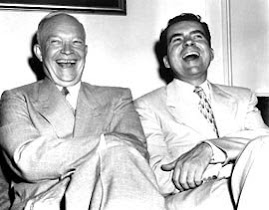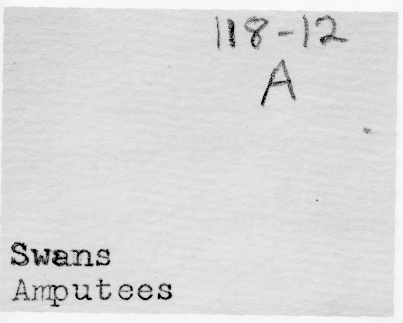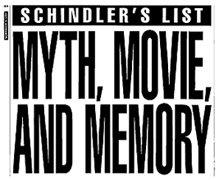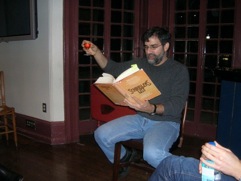
Years ago
Jim O'Donnell - a pioneer in internet-age teaching - said that the role of the teacher would change from that of provider of knowledge... to that of "front end to the universe": from be-all/there-all giver in a room full of receivers and final arbiter of what constitutes relevant knowledge to medium or gateway or traffic cop gently guiding but never blocking the learners' pathways outward to a world of information and knowledge and text that made the teacher a speck on the horizon yet still great in importance if she or he would thrive in the role of medium. Not maker or giver of the medium, but medium itself. There are classrooms today (and it has not much to do with computing hardware available, though a minimum is required...namely a good wireless connection for everyone) in which the new role is possible and the teacher loves playing it.
From time to time here I have mentioned Kenneth Goldsmith's teaching, in part because I adore what Kenny does and in large part because I happen to have access to it, a close look at its development. Kenny's artwork did all this before he taught regularly, but now the pedagogy is catching up with the rest of the project. Here are a few paragraphs Kenny sent me this morning about what the hell is happening in his classroom:
During a recent classroom visit of a visual artist, it occurred to me that we've reached a new paradigm in radical pedagogy. The artist entered the room, greeted the class and began his lecture with a PowerPoint presentation about his work. While he was speaking, he noticed that the class -- all of whom had their laptops open and connected to the internet -- were furiously typing away. He flattered himself that, in the traditional manner, the students were taking copious notes on his lecture, devouring every word he spoke. But what he was not aware of was that the students were engaged in a simultaneous electronic dialogue with each other about what the artist was saying, all played out over the class listserv, which they all had instant access to. During the course of the artist's lecture, dozens of emails, links and photos were blazing back and forth to each other; each email elicited yet more commentary and gloss on the prior emails to the point where what the artist was saying was merely a jumping off point to an investigation of such depth and complexity, that the artist -- or any ideal of traditional pedagogy -- would never have achieved. It was an unsurpassed form of student's active and participatory engagement, but went far astray from what the speaker had in mind.
During the course of the artist's lecture, dozens of emails, links and photos were blazing back and forth to each other; each email elicited yet more commentary and gloss on the prior emails to the point where what the artist was saying was merely a jumping off point to an investigation of such depth and complexity, that the artist -- or any ideal of traditional pedagogy -- would never have achieved. It was an unsurpassed form of student's active and participatory engagement, but went far astray from what the speaker had in mind.
When later told about this, the artist was very disturbed. His ego was mauled and when shown the blizzard of gloss, was more dispirited as he felt much of what had transpired was irrelevant and even irreverent (hastily Photoshopped detournments of images and concepts he brought up). He was flabbergasted that all of this "conversation" was happening and he, the authoritative speaker, was not privy to what was being said.
I had to explain to him the very positive aspects of this new pedagogy, that in fact his words were triggers for engagements and explorations that, while not wholly controlled by him, were catalysts for thinking in ways other than what he had planned. I told him that their engagement was a deeper one than what normally occurs.
And so we have a glimpse into the future. I can envision a class where bodies physically exist in the same space without a spoken word having transpired; where communication happens electronically and instantaneously -- often concurrently -- yet retains a semblance of community and continuity, even warmth and intimacy. What the electronic classroom does is give us new ways of being together. I often tell my students that they are smarter with a laptop connected to the internet than they are without one. And after seeing what the results of this are, I am more convinced that I can never go back to a traditional classroom pedagogy. The role of the professor now is part party host, part traffic cop, full time enabler.
 Years ago Jim O'Donnell - a pioneer in internet-age teaching - said that the role of the teacher would change from that of provider of knowledge... to that of "front end to the universe": from be-all/there-all giver in a room full of receivers and final arbiter of what constitutes relevant knowledge to medium or gateway or traffic cop gently guiding but never blocking the learners' pathways outward to a world of information and knowledge and text that made the teacher a speck on the horizon yet still great in importance if she or he would thrive in the role of medium. Not maker or giver of the medium, but medium itself. There are classrooms today (and it has not much to do with computing hardware available, though a minimum is required...namely a good wireless connection for everyone) in which the new role is possible and the teacher loves playing it. From time to time here I have mentioned Kenneth Goldsmith's teaching, in part because I adore what Kenny does and in large part because I happen to have access to it, a close look at its development. Kenny's artwork did all this before he taught regularly, but now the pedagogy is catching up with the rest of the project. Here are a few paragraphs Kenny sent me this morning about what the hell is happening in his classroom:
Years ago Jim O'Donnell - a pioneer in internet-age teaching - said that the role of the teacher would change from that of provider of knowledge... to that of "front end to the universe": from be-all/there-all giver in a room full of receivers and final arbiter of what constitutes relevant knowledge to medium or gateway or traffic cop gently guiding but never blocking the learners' pathways outward to a world of information and knowledge and text that made the teacher a speck on the horizon yet still great in importance if she or he would thrive in the role of medium. Not maker or giver of the medium, but medium itself. There are classrooms today (and it has not much to do with computing hardware available, though a minimum is required...namely a good wireless connection for everyone) in which the new role is possible and the teacher loves playing it. From time to time here I have mentioned Kenneth Goldsmith's teaching, in part because I adore what Kenny does and in large part because I happen to have access to it, a close look at its development. Kenny's artwork did all this before he taught regularly, but now the pedagogy is catching up with the rest of the project. Here are a few paragraphs Kenny sent me this morning about what the hell is happening in his classroom:During the course of the artist's lecture, dozens of emails, links and photos were blazing back and forth to each other; each email elicited yet more commentary and gloss on the prior emails to the point where what the artist was saying was merely a jumping off point to an investigation of such depth and complexity, that the artist -- or any ideal of traditional pedagogy -- would never have achieved. It was an unsurpassed form of student's active and participatory engagement, but went far astray from what the speaker had in mind.






 "I teach horizontally, meaning that while I might begin with a fixed idea of what I'm going to teach that day, I let it drift rhizomatically way off topic, often pulling it back when it gets too far. I rely on non-fixed materials to teach this way; the whole world is at my fingertips. Should I go off on a tangent about John and Rauschenberg and their love relationship as expressed in Rauschenberg's bed, an image of that bed is always a click away. From there, we can head anywhere into the non-fixed universe, be it film, text or sound. And of course, that always takes us elsewhere. As Cage says, 'We are getting nowhere fast.'"
"I teach horizontally, meaning that while I might begin with a fixed idea of what I'm going to teach that day, I let it drift rhizomatically way off topic, often pulling it back when it gets too far. I rely on non-fixed materials to teach this way; the whole world is at my fingertips. Should I go off on a tangent about John and Rauschenberg and their love relationship as expressed in Rauschenberg's bed, an image of that bed is always a click away. From there, we can head anywhere into the non-fixed universe, be it film, text or sound. And of course, that always takes us elsewhere. As Cage says, 'We are getting nowhere fast.'" 

 that anyone has yet got the imaginative measure of that terrifying day six years ago. Certainly our Tolstoy has not crawled out of the rubble. The closest we have, Don DeLillo, succeeded as an essayist-journalist ("In the Ruins of the Future: Reflections on Terror and Loss in the Shadow of September,” Harper’s, December 2001) but, to my mind, failed as a novelist ("Falling Man"). One reason, perhaps, is that the remembered emotion was instantly buried under a pile of cultural junk.' - Tod Gitlin in his review of Susan Faludi's The Terror Dream (written for
that anyone has yet got the imaginative measure of that terrifying day six years ago. Certainly our Tolstoy has not crawled out of the rubble. The closest we have, Don DeLillo, succeeded as an essayist-journalist ("In the Ruins of the Future: Reflections on Terror and Loss in the Shadow of September,” Harper’s, December 2001) but, to my mind, failed as a novelist ("Falling Man"). One reason, perhaps, is that the remembered emotion was instantly buried under a pile of cultural junk.' - Tod Gitlin in his review of Susan Faludi's The Terror Dream (written for 






























